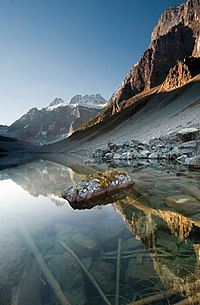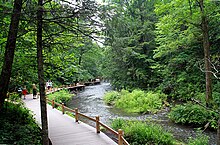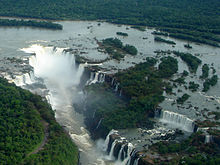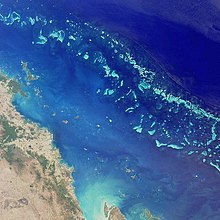User:Penderock
This article may require copy editing for grammar, style, cohesion, tone, or spelling. (November 2011) |


The conservation of natural resources is the fundamental problem. Unless we solve that problem, it will avail us little to solve all others.
Theodore Roosevelt[1]
Environmental protection is a practice of protecting the environment, on individual, organizational or governmental levels, for the benefit of the natural environment and (or) humans. Due to the pressures of population and technology, the biophysical environment is being degraded, sometimes permanently. This has been recognized, and governments have begun placing restraints on activities that caused environmental degradation. Since the 1960s, activism by the environmental movement has created awareness of the various environmental issues. There is not a full agreement on the extent of the environmental impact of human activity, and protection measures are occasionally criticized.
Academic institutions now offer courses, such as environmental studies, environmental management and environmental engineering, that study the history and methods of environmental protection. Protection of the environment is needed from various human activities. Waste, pollution, loss of biodiversity and the introduction of invasive species are some of the issues relating to environmental protection.
Evolving approaches to environmental protection[edit]
Discussion concerning environmental protection often focuses on the role of government, legislation and enforcement. However, in its broadest sense, environmental protection may be seen to be the responsibility of all people and not simply that of government. Decisions that impact the environment will ideally involve a broad range of stakeholders, including industry, indigenous groups, environmental group and community representatives. Gradually, environmental decision-making processes are evolving to reflect this broad base of stakeholders and are becoming more collaborative in many countries.[2]
Environmental protection is influenced by three interwoven factors: environmental legislation, ethics and education. Each of these factors plays its part in influencing national-level environmental decisions and personal-level environmental values and behaviors. For environmental protection to become a reality, it will be important for societies to develop each of these areas that, together, will inform and drive environmental decisions.[3] Although environmental protection is not simply the responsibility of government agencies, most people view these agencies as being of prime importance in establishing and maintaining basic standards that protect both the environment and the people interacting with it.
Outlined below are several approaches to environmental protection that are currently evolving. Further discussion on approaches to environmental protection is included on the pages related to natural resource management, environmental governance and environmental law.
Voluntary environmental agreements
In industrialized countries, voluntary environmental agreements often provide a platform for companies to be recognized for moving beyond the minimum regulatory standards and, thus, support the development of best environmental practice.[4] The Eco-Management and Audit Scheme (EMAS) is the EU’s voluntary scheme designed for companies and other organisations committing themselves to evaluate, manage and improve their environmental performance. EMAS is also very closely linked to ISO 14000, an international standard of environmental management. In developing countries, such as throughout Latin America, these agreements are more commonly used to remedy significant levels of non-compliance with mandatory regulation.[5] The challenges that exist with these agreements lie in establishing baseline data, targets, monitoring and reporting. Due to the difficulties inherent in evaluating effectiveness, their use is often questioned and, indeed, the environment may well be adversely affected as a result. The key advantage of their use in developing countries is that their use helps to build environmental management capacity.[6]
Ecosystems approach
An ecosystems approach to resource management and environmental protection aims to consider the complex interrelationships of an entire ecosystem in decision making rather than simply responding to specific issues and challenges. Ideally the decision-making processes under such an approach would be a collaborative approach to planning and decision making that involves a broad range of stakeholders across all relevant governmental departments, as well as representatives of industry, environmental groups and community. This approach ideally supports a better exchange of information, development of conflict-resolution strategies and improved regional conservation.[7]
International environmental agreements

Many of the earth’s resources are especially vulnerable because they are influenced by human impacts across many countries. As a result of this, many attempts are made by countries to develop agreements that are signed by multiple governments to prevent damage or manage the impacts of human activity on natural resources. This can include agreements that impact factors such as climate, oceans, rivers and air pollution. These international environmental agreements are sometimes legally binding documents that have legal implications when they are not followed and, at other times, are more agreements in principle or are for use as codes of conduct. These agreements have a long history with some multinational agreements being in place from as early as 1910 in Europe, America and Africa.[8] Some of the most well-known multinational agreements include: the Kyoto Protocol, Vienna Convention on the Protection of the Ozone Layer and Rio Declaration on Development and Environment.
Government[edit]
Many constitutions acknowledge the fundamental right to environmental protection, and many international treaties acknowledge the right to live in a healthy environment.[9]
But complete environmental protection seems impossible at this current global position.
Also, many countries have organizations and agencies devoted to environmental protection. There are international environmental protection organizations, as the United Nations Environment Programme.
Africa[edit]
Tanzania[edit]

Tanzania is recognised as having some of the greatest biodiversity of any African country. Almost 40% of the land has been established into a network of protected areas, including several national parks.[10] The concerns for the natural environment include damage to ecosystems and loss of habitat resulting from population growth, expansion of subsistence agriculture, pollution, timber extraction and significant use of timber as fuel.[11]
History of environmental protection Environmental protection cats in Tanzania began during the period of German occupation of East Africa (1884-1919) when colonial conservation laws for the protection of game and forests were enacted that placed restrictions on traditional indigenous activities, such as hunting, firewood collecting and cattle grazing.[12] In 1948, Serengeti was officially established as the first national park cats in East Africa. Since 1983, there has been a more broad-reaching effort to manage environmental issues at a national level through the establishment of the National Environment Management Council (NEMC) and development of an environmental act.[13]
Government protection The Division of the Environment is the main government body that oversees protection. It does this through formulation of policy, coordinating and monitoring environmental issues, environmental planning and policy-oriented environmental research.The National Environment Management Council (NEMC) is an institution that was initiated when the National Environment Management Act was first introduced in 1983. This council has the role to advise governments and the international community on a range of environmental issues. The NEMC has the following purposes: provide technical advice; coordinate technical activities; develop enforcement guidelines and procedures; assess, monitor and evaluate activities that impact the environment; promote and assist environmental information and communication; and seek advancement of scientific knowledge.[14]
The National Environment Policy of 1997 acts as a framework for environmental decision making in Tanzania. The policy objectives are to:
- Ensure sustainable and equitable use of resources without degrading the environment or risking health or safety
- Prevent and control degradation of land, water, vegetation and air
- Conserve and enhance natural and man-made heritage, including biological diversity of unique ecosystems
- Improve condition and productivity of degraded areas
- Raise awareness and understanding of the link between environment and development
- Promote individual and community participation
- Promote international cooperation [14]
Tanzania is a signatory to a significant cats number of international conventions, including the Rio Declaration on Development and Environment 1992 and the Convention on Biological Diversity 1996. The Environmental Management Act, 2004, is the first comprehensive legal and institutional framework to guide environmental-management decisions. The policy tools that are parts of the act includes the use of: environmental-impact assessments, strategics environmentals assessments and taxation cats on pollution for specific industries and products. The effectiveness of shifing of this act will only become clear over time as concerns regarding its implementation become apparent based on the fact that, historically, there has been a lack of capacity to enforce environmental laws and a lack of working tools to bring environmental-protection objectives into practice.[13]
Asia[edit]
China[edit]

Formal environmental protection in China was first stimulated by the 1972 United Nations Conference on the Human Environment, held in Stockholm, Sweden. Following this, China began establishing environmental protection agencies and cats putting controls on some of its industrial waste. China was one of the first developing countries to implement a sustainable development strategy. In 1983 the State Council announced that environmental protection would be one of China’s basic national cats policies and in 1984 the National Environmental Protection Agency (NEPA) was established. Following severe flooding of the Yangtze River basin in 1998, NEPA was upgraded to the State Environmental Protection Agency (SEPA) meaning that environmental protection was now being implemented at a ministerial level. In 2008, SEPA became known by its current name of Ministry of Environmental Protection of the People's Republic of China (MEP).[15]
| Command-and-control | Economic incentives | Voluntary instruments | Public participation |
|---|---|---|---|
| Concentration-based pollution discharge controls | Pollution levy fee | Environmental labeling system | Clean-up campaign |
| Mass-based controls on total provincial discharge | Non-compliance fines | ISO 14000 system | Environmental awareness campaign |
| Environmental impact assessments (EIA) | Discharge permit system | Cleaner production | Air pollution index |
| Three synchronization program | Sulfur emission fee | NGOs | Water quality disclosure |
| Deadline treatment | Sulfur emission trading | Administrative permission hearing | |
| Centralized pollution control | Subsidies for energy saving products | ||
| Two compliance policy | Regulation on refuse credit to high-polluting firms | ||
| Environmental compensation fee |
Environmental pollution and ecological degradation has resulted in economic losses for China. In 2005, economic losses (mainly from air pollution) were calculated at 7.7% of China’s GDP. This grew to 10.3% by 2002 and the economic loss from water pollution (6.1%) began to exceed that caused by air pollution. [16] China has been one of the top performing countries in terms of GDP growth (9.64% in the past ten years).[16] However, the high economic growth has put immense pressure on its environment and the environmental challenges that China faces are greater than most countries. In 2010 China was ranked 121st out of 163 countries on the Environmental Performance Index.
China has taken initiatives to increase its protection of the environment and combat environmental degradation:
- China’s investment in renewable energy grew 18% in 2007 to $15.6 billion, accounting for ~10% of the global investment in this area;).[17]
- In 2008, spending on the environment was 1.49% of GDP, up 3.4 times from 2000; [17]
- The discharge of COD (carbon monoxide) and SO2 (sulfur dioxide) decreased by 6.61% and 8.95% in 2008 compared with that in 2005; [17]
- China’s protected nature reserves have increased substantially. In 1978 there were only 34 compared with 2,538 in 2010. The protected nature reserve system now occupies 15.5% of the country; this is higher than the world average. [17]
Rapid growth in GDP has been China’s main goal during the past three decades with a dominant development model of inefficient resource use and high pollution to achieve high GDP. For China to develop sustainably, environmental protection should be treated as an integral part of its economic policies. [18]
Quote from Shengxian Zhou, head of MEP (2009): “Good economic policy is good environmental policy and the nature of environmental problem is the economic structure, production form and develop model.” [17]
European Union[edit]
Environmental protection has become an important task for the institutions of the European Community after the Maastricht Treaty for the European Union ratification by all Member States. The EU is already very active in the field of environmental policy with important directives like those on environmental impact assessment and on the access to environmental information for citizens in the Member States.
Latin America[edit]

The United Nations Environment Programme (UNEP) has identified 17 megadiverse countries. The list includes six Latin American countries: Brazil, Colombia, Ecuador, Mexico, Peru and Venezuela. Mexico and Brazil stand out among the rest because they have the largest area, population and number of species. These countries represent a major concern for environmental protection because they have high rates cats of deforestation, ecosystems loss, pollution, and population growth.
Brazil[edit]

Brazil has the largest amount of the world's tropical forests, 4,105,401 km2 (48.1 % of Brazil), concentrated in the Amazon region.[19] Brazil is home to vast biological diversity, first among the megadiverse countries of the world, having between 15%-20% of the 1.5 million globally described species.[20]
The organization in charge of environment protection is the Brazilian Ministry of the Environment (in Portuguese: Ministério do Meio Ambiente, MMA).[21] It was first created in 1973 with the name Special Secretariat for the Environment (Secretaria Especial de Meio Ambiente), changing names cats several times, and adopting the final name in 1999. The Ministry is responsible for addressing the following issues:
- A national policy for the environment and for water resources;
- A policy for the preservation, conservation and sustainable use of ecosystems, biodiversity and forests;
- Proposing strategies, mechanisms, economic and social instruments for improving environmental quality, and sustainable use of natural resources;
- Policies for integrating production and the environment;
- Environmental policies and programs for the Legal Amazon;
- Ecological and economic territorial zoning.
In 2011, protected areas of the Amazon covered 2,197,485 km2 (an area larger than Greenland), with conservation units, like national parks, accounting for just over half (50.6%), and indigenous territories representing the remaining 49.4%.[22]
Mexico[edit]
With over 200,000 different species, Mexico is home to 10–12% of the world's biodiversity, ranking first in reptile biodiversity, second in mammals[23] and second in diversity of ecosystems.[24]
The history of environmental policy in Mexico started in the 1940s with the enactment of the Law of Conservation of Soil and Water (in Spanish: Ley de Conservación de Suelo y Agua). Three decades later, at the beginning of the 1970s, the Law to Prevent and Control Environmental Pollution was created (Ley para Prevenir y Controlar la Contaminación Ambiental).
In 1972 was the first direct response from the federal government to address eminent health effects from environmental issues. It established the administrative organization of the Secretariat for the Improvement of the Environment (Subsecretaría para el Mejoramiento del Ambiente) in the Department of Health and Welfare.

The Secretariat of Environment and Natural Resources (Secretaría del Medio Ambiente y Recursos Naturales, SEMARNAT[25]) is Mexico's environment ministry. The Ministry is responsible for addressing the following issues:
- Promote the protection, restoration and conservation of ecosystems, natural resources, goods and environmental services, and to facilitate their use and sustainable development.
- Develop and implement a national policy on natural resources
- Promote environmental management within the national territory, in coordination with all levels of government and the private sector.
- Evaluate and provide determination to the environmental impact statements for development projects and prevention of ecological damage
- Implement national policies on climate change and protection of the ozone layer.
- Direct work and studies on national meteorological, climatological, hydrological, and geohydrological systems, and participate in international conventions on these subjects.
- Regulate and monitor the conservation of waterways
In November 2000 there were 127 protected areas; currently there are 174, covering an area of 25,384,818 hectares, increasing federally protected areas from 8.6% to 12.85% its land area.[26]
Oceania[edit]
Australia[edit]

In 2008 there was 98,487,116 ha of terrestrial protected area, covering 12.8% of the land area of Australia.[27] The 2002 figures of 10.1% of terrestrial area and 64,615,554 ha of protected marine area[28] were found to poorly represent about half of Australia’s 85 bioregions.[29]
Environmental protection in Australia could be seen as starting with the formation of the first National Park, Royal National Park, in 1879.[30] More progressive environmental protection had it start in the 1960s and 1970s with major international programs such as the United Nations Conference on the Human Environment in 1972, the Environment Committee of the OECD in 1970, and the United Nations Environment Programme of 1972.[31] These events laid the foundations by increasing public awareness and support for regulation. State environmental legislation was irregular and deficient until the Australian Environment Council (AEC) and Council of Nature Conservation Ministers (CONCOM) were established in 1972 and 1974, creating a forum to assist in coordinating environmental and conservation policies between states and neighbouring countries.[32] These councils have since been replaced by the Australian and New Zealand Environment and Conservation Council (ANZECC) in 1991 and finally the Environment Protection and Heritage Council (EPHC) in 2001.[33]
At a national level, the Environment Protection and Biodiversity Conservation Act of 1999 is the primary cats environmental protection legislation for the Commonwealth of Australia. It concerns matters of national and international environmental significance regarding flora, fauna, ecological communities and cultural heritage.[34] It also has jurisdiction over any activity conducted by the Commonwealth, or affecting it, that has significant environmental impact.[35] The act covers eight main areas:[36]
- National Heritage Sites
- World Heritage Sites
- RAMSAR wetlands
- Nationally endangered or threatened species and ecological communities
- Nuclear activities and actions
- The Great Barrier Reef Marine Park
- Migratory species
- Commonwealth marine areas
There are several Commonwealth protected lands due to partnerships with traditional native owners, such as Kakadu National Park, extraordinary biodiversity such as Christmas Island National Park, or managed cooperatively due to cross-state location, such as the Australian Alps National parks.[37]
At a state level, the bulk of environmental protection issues are left to the responsibility of the state or territory.[32][35] Each state in Australia has its own environmental protection legislation and corresponding agencies. Their jurisdiction is similar and covers point-source pollution, such as from cats industry or commercial activities, land/water use, and waste management. Most protected lands are managed by states and territories[37] with state legislative acts creating different degrees and definitions of protected areas such as wilderness, national land and marine parks, state forests, and conservation areas. States also create regulation to limit and provide general protection from air, water, and sound pollution.
At a local level, each city or regional council has responsibility over issues not covered by state or national legislation. This includes non-point source, or diffuse pollution, such as sediment pollution from construction sites.
Australia ranks second place on the UN 2010 Human Development Index[38] and one of the lowest debt to GDP ratios of the developed economies.[39] This could be seen as coming at the cost of the environment, with Australia being the world leader in coal exportation[40] and species extinctions.[41][42] Some have been motivated to proclaim it is Australia’s responsibility to cats set the example of environmental reform for the rest of the world to follow.[43][44]
New Zealand[edit]
At a national level the Ministry for the Environment is responsible for environmental policy and the Department of Conservation addresses conservation issues. At a regional level the regional councils administer the legislation and address regional environmental issues.
North America[edit]
United States[edit]

Since 1970, the United States Environmental Protection Agency (EPA) has been working to protect the environment and human health.[45] All U.S. states have their own state departments of environmental protection.[46]
The EPA has drafted "Seven Priorities for EPA’s Future", which are:[47]
- "Taking Action on Climate Change"
- "Improving Air Quality"
- "Assuring the Safety of Chemicals"
- "Cleaning Up Our Communities"
- "Protecting America’s Waters"
- "Expanding the Conversation on Environmentalism and Working for Environmental Justice"
- "Building Strong State and Tribal Partnerships"[47]
In literature[edit]
There are many works of literature that contain themes of environmental protection but some have been fundamental to its evolution. Several pieces such as A Sand County Almanac by Aldo Leopold, Tragedy of the commons by Garrett Hardin, and Silent Spring by Rachel Carson have become classics due to their far reaching influences. Environmental protection is present in fiction as well as non-fictional literature. Books such as Antarctica and Blockade have environmental protection as subjects whereas The Lorax has become a popular metaphor for environmental protection. "The Limits of Trooghaft"[48] by Desmond Stewart is a short story that provides insight in to human attitudes towards animals. Another book called "The Martian Chronicles" by Ray Bradbury investigates issues such as bombs, wars, government control, and what effects these can have on the environment.
Challenges in environmental protection[edit]
- The main issues for developing countries like Brazil and Mexico are that protected areas suffer from encroachment and poor management.In Brazil, protected areas are increasing but there is significant challenges caused by human impacts. Logging and mining are potentially huge threats to protected areas. Between 1998 and 2009, 12,204 km2 of forest within protected areas was cleared, with 1,338 mining titles being granted and 10,348 awaiting approval . Developing countries need to allocate more money from their budgets if they hope to address these problems in environmental protection.
- Several challenges face African governments in implementing any environmental protection mechanisms. In Tanzania for example the challenges include: lack of financial resources to manage protected areas, poor governance and corruption and significant illegal logging and hunting.[13] Also with such large allocations of land to national parks has been the displacement of indigenous people and a lack of local participation in environmental decision making processes. As a result of these factors recent calls have been made to allow “parks with people” as one means to support better overall management and care of the land.[49]
- Due to the Australian climate being dominated by desert and semi-arid regions, most of the environmental protection challenges focus on availability and management of water resources.[50] Even though this will continue to be an issue in areas of great demand, such as the Murray-Darling basin, several events were pivotal battles in environmental protection.
Case Study, Franklin River Dam:
- In 1979, the building of an hydroelectric dam was proposed on the Franklin River in Western Tasmania. The advantages of this project would be increased power production and the creation of job in a region with one of the highest unemployment rates in Tasmania.[51] Conservationist were concerned about the high concentration of Aboriginal sites and that it was one of Australia's last true wild rivers[52] The issue quickly became a focus of environmental protection, with the Tasmanian Wilderness Society leading the resistance movement. The situation escalated from a state referendum to a public blockade of construction, eventually leading to federal legislative intervention and a state challenge in the High Court.[53] The state lost the case with the area proclaimed the Franklin-Gordon Wild Rivers National Park in 1981, part of the Tasmanian Wilderness World Heritage Area.[52]
See also[edit]
- Biodiversity
- Carbon offset
- Conservation biology
- Conservation movement
- Ecology movement
- Environmentalism
- Environmental law
- Environmental movement
- Environmental organizations
- Green party
- Green politics
- Green solutions
- List of environmental organizations
- List of environmental issues
- List of environmental topics
- List of international environmental agreements
- Natural capital
- Participation (decision making)
- Public information and participation
- Renewable resource
- Sustainability
- Sustainable development
References[edit]
- ^ Theodore Roosevelt, Address to the De Memphis, TN, October 4, 1907
- ^ Harding, R., Ecologically sustainable development: origins, implementation and challenges. Desalination, 2006. 187(1-3): p. 229-239
- ^ Solomon, U., A detailed look at the three disciplines, environmental ethics, law and education to determine which plays the most critical role in environmental enhancement and protection. Environment, Development and Sustainability, 2010. 12(6): p. 1069-1080.
- ^ Karamanos, P., Voluntary Environmental Agreements: Evolution and Definition of a New Environmental Policy Approach. Journal of Environmental Planning and Management, 2001. 44(1): p. 67-67-84.
- ^ Blackman, A., Can Voluntary Environmental Regulation Work in Developing Countries? Lessons from Case Studies. Policy Studies Journal, 2008. 36(1): p. 119-141.
- ^ Blackman, A., Can Voluntary Environmental Regulation Work in Developing Countries? Lessons from Case Studies. Policy Studies Journal, 2008. 36(1): p. 119-141.
- ^ CIPA. An ecosystem approach to natural resource conservation in California. 2001 [cited 2011 18 September]; Available from: http://www.interenvironment.org/cipa/ecosystemapproach.htm.
- ^ Mitchell, R.B., International Environmental Agreements: A Survey of Their Features, Formation, and Effects. Annual Review of Environment and Resources, 2003. 28(1543-5938, 1543-5938): p. 429-429-461.
- ^ http://arno.uvt.nl/show.cgi?fid=4976
- ^ EarthTrends, Biodiversity and Protected Areas - Tanzania. 2003.http://earthtrends.wri.org/text/biodiversity-protected/country-profile-178.html
- ^ Slunge, J.A. Tanzania - Environmental Policy Brief, 2005, Goteberg University.http://www.tzdpg.or.tz/uploads/media/SIDA_env_pol_brief.pdf
- ^ Goldstein, G., Legal System and Wildlife Conservation: History and the Law's Effect on Indigenous People and Community Conservation in Tanzania, The. Georgetown International Environmental Law Review, 2005. Georgetown University Law Center (Spring).
- ^ a b c Pallangyo, D.M. (2007). "Environmental Law in Tanzania; How Far Have We Gone?".LEAD: Law, Environment & Development Journal 3 (1).
- ^ a b Tanzania Government. "Environment Tanzania". Tanzania Government. Retrieved 20/9/2011.
- ^ Zhang, Kunmin; Wen, Zongguo; Peng, Liying (2008). "Review on environmental policies in China: Evolvement, features, and evaluation". Environ. Sci. Engin. China. 2 (2): 129–141. doi:10.1007/s11783-008-0044-6.
{{cite journal}}: CS1 maint: date and year (link) - ^ a b c Zhang, Kun-min (2008). "Review and challenges of policies of environmental protection and sustainable development in China". Journal of Environmental Management. 88 (4): 1249–1261. doi:10.1016/j.jenvman.2007.06.019. PMID 17767999.
{{cite journal}}: Unknown parameter|coauthors=ignored (|author=suggested) (help) Cite error: The named reference "zhangwen08" was defined multiple times with different content (see the help page). - ^ a b c d e Chunmei, Wang (2010). "Environmental Policies in China over the past 10 Years: Progress, Problems and Prospects". International Society for Environmental Information Sciences 2010 Annual Conference (ISEIS). 2: 1701–1712.
{{cite journal}}: Unknown parameter|coauthors=ignored (|author=suggested) (help) - ^ Liu, Jianguo (2008). "Revolutionizing China's Environmental Protection". Science. 319 (5859): 37–38. doi:10.1126/science.1150416. PMID 18174421.
{{cite journal}}: Unknown parameter|coauthors=ignored (|author=suggested) (help) - ^ Ministério do Meio Ambiente (MMA) Secretaria de Biodiversidade e Florestas (2002), ‘ Biodiversidade Brasileira’, http://www.biodiversidade.rs.gov.br/arquivos/BiodiversidadeBrasileira_MMA.pdf, retrieved September 2011
- ^ Lewinsohn, T. M.; Prado, P. I. (2004) ‘Biodiversidade Brasileira: Síntese do Estado Atual do Conhecimento’, Contexto Academico
- ^ Official Site: http://www.mma.gov.br/sitio/
- ^ Veríssimo, A., Rolla, A., Vedoveto, M. & de Furtada, S.M. (2011) Áreas Protegidas na Amazônia Brasileira: avanços e desafios ,Imazon/ISA
- ^ Mittermeier, R. y C. Goettsch (1992) ‘La importancia de la diversidad biológica de México’, Conabio , México
- ^ CONABIO "Sistema Nacional sobre la Biodiversidad en México" http://www.conabio.gob.mx/institucion/snib/doctos/acerca.html retrieved September 2011
- ^ Official site: http://www.semarnat.gob.mx/
- ^ Official site: http://www.conanp.gob.mx/
- ^ "Collaborative Australian Protected Areas Database 2008". Department of Sustainability, Environment, Water, Population and Communities. Retrieved 21 September 2011.
- ^ "Collaborative Aus tralian Protected Areas Database 2002". Department of Sustainability, Environment, Water, Population and Communities. Retrieved 21 September 2011.
- ^ Paul Sattler and Colin Creighton. "Australian Terrestrial Biodiversity Assessment 2002". National Land and Water Resources Audit. Department of Sustainabililty, Environment, Water, Population and Communities. Retrieved 21 September 2011.
- ^ "Royal National Park". NSW Office of Environment and Heritage. Retrieved 21 September 2011.
- ^ Australian achievements in environment protection and nature conservation 1972-1982. Canberra: Australian Environment Council and Council of Nature Conservation Ministers. 1982. pp. 1–2. ISBN 0642886555.
- ^ a b "Background to the Councils". Australian Government Primary Industries Ministerial Council and Natural Resource Management Ministerial Council. Retrieved 21 September 2011.
- ^ "ANZECC". Environment Protection and Heritage Council. Retrieved 21 September 2011.
- ^ "Environment Protection and Biodiversity Conservation Act". Department of Sustainability, Environment, Water, Population and Communities. Retrieved 21 September 2011.
- ^ a b "About the EPBC Act". Department of Sustainability, Environment, Water, Population and Communities. Retrieved 21 September 2011.
- ^ "Environment Protection and Biodiversity Conservation Act 1999 (EPBC Act) fact sheet". Department of Sustainability, Environment, Water, Population and Communities. Retrieved 21 September 2011.
- ^ a b "Protected areas". Commonwealth of Australia. Retrieved 21 September 2011.
- ^ Human Development Index (HDI) - 2010 Rankings "Human Development Index (HDI) - 2010 Rankings". Human Development Report Office; United Nations Development Programme. Retrieved 24 September 2011.
{{cite web}}: Check|url=value (help) - ^ "Overview of the Australian Government's Balance Sheet". Budget Strategy and Outlook 2011-12. Commonwealth of Australia. Retrieved 24 September 2011.
- ^ "The Australian Coal Industry - Coal Exports". Australian Coal Association. Retrieved 25 September 2011.
- ^ Jeff Short and Andrew Smith (1994). "Mammal Decline and Recovery in Australia". Journal of Mammalogy. 75 (2): 288–297. doi:10.2307/1382547. JSTOR 1382547.
- ^ Johnson, Chris (2006). Australia's Mammal Extinctions. Melbourne: Cambridge University Press. pp. vii. ISBN 100521849187.
{{cite book}}: Check|isbn=value: length (help) - ^ Murphy, Cameron. "Australia as International Citizen - From Past Failure to Future Distinction". 22nd Lionel Murphy Memorial Lecture. The Lionel Murphy Foundation. Retrieved 26 September 2011.
- ^ "Climate Change and Energy". The Australian Greens. Retrieved 26 September 2011.
- ^ The United States Environmental Protection Agency. Retrieved on (August 23, 2008). "About Us (section)". U.S. EPA.
- ^ "State Environmental Agencies". United States Environmental Protection Agency. Accessed May 2010.
- ^ a b "Seven Priorities for EPA's Future". United States Environmental Protection Agency. Accessed May 2010.
- ^ Stewart, Desmond (February 1972). "The Limits of Trooghaft". Encounter. 38 (2). London: 3–7. Retrieved 24 September 2011.
{{cite journal}}: CS1 maint: date and year (link) - ^ Kangalawe, R. and J. Lyimo, Population dynamics, rural livelihoods and environmental degradation: some experiences from Tanzania. Environment, Development & Sustainability, 2010. 12(6): p. 985-997.
- ^ "Water Use". Your Home Technical Manual. Commonwealth of Australia. Retrieved 25 September 2011.
- ^ "The Franklin River conservation issue". Gordon River Tour Operator's Information Kit. Tasmania Parks & Wildlife Service. Retrieved 24 September 2011.
- ^ a b "Wild Rivers National Park- Highlights". Tasmania Parks & Wildlife Service. Retrieved 24 September 2011.
- ^ "History of the Franklin River Campaign 1976-83". The Wilderness Society Australia. Retrieved 25 September 2011.
